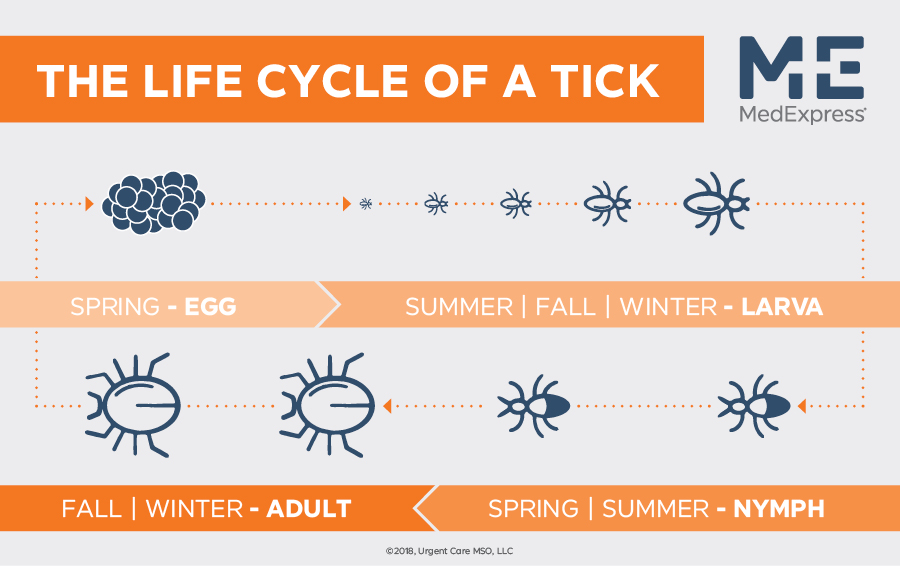August 15, 2024
You may know there are measures to help prevent lyme disease, including proactively checking for ticks during warmer months, but we’re here to help you understand why and how. There are many kinds of ticks, but we’re sharing the ins and outs of the deer tick, also known as the blacklegged tick.

Not all ticks carry Lyme disease, but unfortunately, deer ticks do, and they’re often in search of a host to help them reach the next stage of their life cycle. To best avoid becoming their host, read on to learn the habits and habitats of the deer tick as it transitions through its life.
Tick Eggs
Female ticks typically lay their eggs in the spring after completing their two year life span. In fact, their life purpose is to reproduce and by feeding throughout each life stage, they’re gaining the strength they need to mate and do so. Because a tick needs to completely detach from its host before beginning the reproduction process, ticks aren’t physically able to lay eggs directly on a host. But, they’ll lay eggs just about anywhere else; ticks have been found to lay eggs in coat linings, carpeting, furniture, outdoor leaf brush, and other warm, soft places inside or outside.
Even though a tick is no more than 2mm in size, one tick can lay thousands of eggs. But don’t worry, tick egg nests, which are batches of tick eggs, are actually easier to spot than ticks themselves, and they aren’t infectious at this stage. The eggs are often brown and red in color and appear to be translucent. If you find a batch of tick eggs, you can use salt as a natural product to begin drying them out, but it’s best to call an exterminator to identify an appropriate pesticide product or plan of action. It’s always better to be safe than sorry.
MedExpress Pro Tip: Keep up with your weekly cleaning and de-cluttering during the spring and summer seasons. The more you monitor these tick-attractive spaces inside and outside of your home, the better chance you have of stopping an infestation from developing.

Looking for an alternative version of the above infographic?
Stage 1: Larva
Later in the summer, tick eggs hatch into larvae. Once they reach this life stage, the thousands of tiny larvae that were once eggs are ready and waiting for their first host to pass by. A tick needs to feed on the blood of a host during each life stage in order to pass onto the next. Larvae are not infectious at their time of hatching. However at this stage, they seek smaller mammals as their first host, and one of the most common mammals they feed on is the white-footed mouse.
These mice are efficient transmitters of Lyme disease. If a tick is able to find and feed on a mammal who carries the disease like the white-footed mouse, the disease is then transmitted to the tick. If the larvae aren’t able to latch onto a mouse, they’ll feed on other small mammals like raccoons or even birds who may not have the disease. If the larvae feed on animals that aren’t infected, the larvae themselves do not become infected with Lyme disease at this point in their life. Larvae do not carry tick-borne illnesses at the start, but they can become carriers of Lyme when they suck the blood of an already infected mammal who was previously exposed to the Lyme disease causing bacteria, Borrelia burgdoferi.
Larvae growth peeks in August. When they are done feeding on a host and are full of blood, Larvae fall to the ground and begin transitioning to their next life stage as nymphs.
Stage 2: Nymph
Ticks become nymphs between the fall and spring. However, because ticks are inactive when temperatures drop below 45 degrees Fahrenheit, it’s less likely to get a tick bite during winter months. Typically they’ll nest on a host without feeding, or sit dormant in leaf litter not seeking a host to feed on. Despite that, if you and your family venture out hiking on an unusually warm day, it's still important to perform tick checks before returning indoors.

Ticks, at the nymph stage, become the biggest concern during the spring as they begin to search for their next host when the warmer weather breaks. During the months of May, June, and July, nymphs will crawl up tall blades of grass and brush to reach their host. Ticks don’t jump or fly. A nymph will wait for a desirable host to pass by and they’ll latch onto it when they make contact. This is called questing.
As the weather starts changing, the sun is shining, and your excitement to be outdoors grows, don’t forget to use a repellant spray, wear long clothing that covers the skin, and monitor your dog’s activity, too. Dogs aren’t a tick’s first choice as a host, but your pets become an easy substitute when they can’t come in contact with their primary choice, a deer.
In fact, we suggest consulting your veterinarian before the warmer days arrive. Often your veterinarian will recommend that your family pets be treated with tick and flea products. In addition to seeking a protectant, you should check your animal’s body for ticks before coming indoors, just as you would with your children.
When a nymph does find a host, it’ll typically hang tight and feed from it for four or five days. If the nymph was already infected with Lyme disease from a host during its larva stage, it could infect the new host at this time or anytime moving forward. If the nymph wasn’t infected during its larva stage, it could become infected from its host at the nymph stage.
Stage 3: Adult
Once the nymph is saturated with blood, it will fall off of its host and come to its adult life stage during the fall. Once again, at the adult stage, the tick will look for its third and final host for feeding.1
Ticks prefer to feed on the blood from three different hosts during their lifetime. Unfortunately, humans can serve as one of their hosts in either the nymph or adult stage and because of this, Lyme disease can be transmitted to us if the tick was infected by a previous host. The Centers for Disease Control and Prevention shares that a tick would typically have to be attached to the skin for 36 – 48 hours or more to transmit the disease.2
Dependent on the time of year and weather conditions when the adult ticks feed from their final host, they will nest or begin mating. Males typically die after mating with one or two females, and females will reproduce by laying thousands of eggs during the spring months, and die shortly after that.1
Coming In Contact with a Deer Tick
Even though you have educated yourself on the tick life cycle and have made use of our tips to keep you safe, you and your family may still come in contact with a tick. If you do find a tick on yourself or a loved one, you can remove it with tweezers, but in doing so, you face the risk of breaking the tick – leaving its feeding tube and tick barbs in your skin.

To ensure you safely and properly remove the tick from your body, schedule an appointment or just walk in to your neighborhood MedExpress center. If you were bitten by a deer tick, MedExpress can provide a Lyme disease test. If it’s your furry friend that you find a tick on, call your veterinarian for instructions.
Originally published May 2018. Updated August 2024.
share this post on Facebook
References:
1 CDC. Tick Lifecycles. Last updated May 15, 2024. Accessed August 9, 2024.
2 CDC: How Lyme Disease Spreads. Last updated May 15, 2024. Accessed August 9, 2024.
